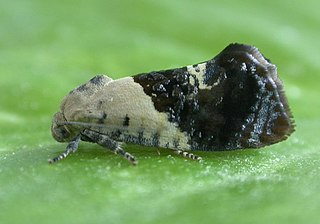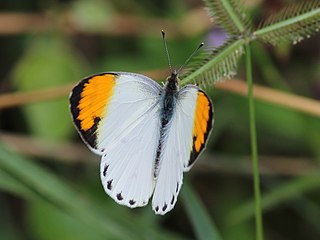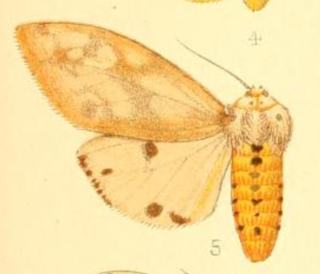Related Research Articles

Agrochola circellaris, The Brick, is a species of moth of the family Noctuidae. It is distributed throughout most of Europe, Asia Minor and Armenia.

Ixias pyrene, the yellow orange tip, is a small butterfly of the family Pieridae, that is, the yellows and whites, which is found in Sri Lanka, India and southeast Asia.

Colotis etrida, the little orange tip, is a species of butterfly in the family Pieridae. It is native to India, Sri Lanka and Pakistan.

Hypolimnas misippus, the Danaid eggfly, mimic, or diadem, is a widespread species of nymphalid butterfly. It is well known for polymorphism and mimicry. Males are blackish with distinctive white spots that are fringed in blue. Females are in multiple forms that include male-like forms while others closely resemble the toxic butterflies Danaus chrysippus and Danaus plexippus. They are found across Africa, Asia, and Australia. In the new world they are found in the West Indies, with strays in Central and North America.

Eupselia satrapella is a species of moth of the family Depressariidae. It is found in Australia, where it has been recorded from Queensland, New South Wales and the Australian Capital Territory.

Hypertropha chlaenota is a species of moth of the family Depressariidae first described by Edward Meyrick in 1887. It is found in Australia, where it has been recorded from Victoria, Queensland, New South Wales, the Australian Capital Territory and South Australia.

Grammodes stolida, the geometrician, is a moth of the family Erebidae. The species was first described by Johan Christian Fabricius in 1775. It is found in Africa, southern Europe, most of Asia and Australia. It migrates to central and northern Europe as far north as England, Denmark and Finland.

Grotella septempunctata is a moth in the genus Grotella, of the family Noctuidae. The species was first described by Leon F. Harvey in 1875. It can be found in North America, from Texas to Colorado.

Nycteola revayana, the oak nycteoline, is a moth of the family Nolidae. The species was first described by Giovanni Antonio Scopoli in 1772. It is found from Europe and east across the Palearctic to Japan and India.

Colotis aurora, the sulphur orange tip or plain orange-tip, is a butterfly in the family Pieridae. It is found in Asia and Africa. The nominate subspecies, Colotis aurora aurora is found in India and Sri Lanka. The other subspecies, Colotis aurora evarne is found in Mauritania, Senegal, the Gambia, Mali, Burkina Faso, Ghana, Benin, Nigeria, Chad, Sudan, Ethiopia, Uganda, Kenya, Rwanda, Tanzania, the Democratic Republic of the Congo, Somalia, and southern Arabia.

Spilosoma rava is a moth in the family Erebidae. It was described by Herbert Druce in 1898. It is found in Cameroon, the Democratic Republic of the Congo, Equatorial Guinea, Gabon, Ghana, Kenya, Liberia, Nigeria, Senegal, the Gambia and Uganda.
Nymphicula junctalis is a moth in the family Crambidae. It was described by George Hampson in 1891. It is found in India in the Nilgiri Mountains and Kanara district. Records from Japan refer to Nymphicula yoshiyasui.
Haimbachia strigulalis is a moth in the family Crambidae. It was described by George Hampson in 1896. It is found in India, Sri Lanka and China.
Metallarcha pseliota is a moth in the family Crambidae. It was described by Edward Meyrick in 1887. It is found in Australia, where it has been recorded from Western Australia.

Nacoleia mesochlora is a moth in the family Crambidae. It was described by Edward Meyrick in 1884. It is found in Australia, where it has been recorded from Queensland, the Northern Territory, New South Wales, Victoria, South Australia and Western Australia.
Pilocrocis dichocrosialis is a moth in the family Crambidae. It was described by George Hampson in 1912. It is found in Cameroon, the Democratic Republic of the Congo (Katanga), Malawi, Mozambique, Zambia and Zimbabwe.
Polygrammodes supremalis is a moth in the family Crambidae. It was described by William Schaus in 1920. It is found in Paraná, Brazil.
Praeacrospila patricialis is a moth in the family Crambidae. It was described by William Schaus in 1912. It is found in Costa Rica.
Stenorista fortunata is a moth in the family Crambidae. It was described by Schaus in 1912. It is found in Costa Rica.
Ulopeza sterictodes is a moth in the family Crambidae. It was described by George Hampson in 1912. It is found in Papua New Guinea.
References
- ↑ Nuss, M.; et al. (2003–2014). "GlobIZ search". Global Information System on Pyraloidea. Retrieved July 15, 2014.
- ↑ Journal of the Bombay Natural History Society
| This Odontiinae-related article is a stub. You can help Wikipedia by expanding it. |